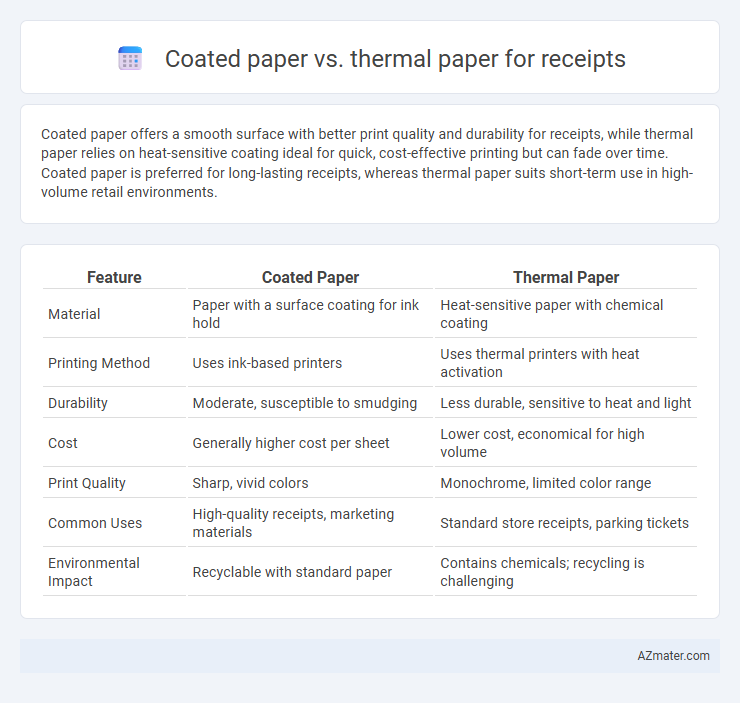Coated paper offers a smooth surface with better print quality and durability for receipts, while thermal paper relies on heat-sensitive coating ideal for quick, cost-effective printing but can fade over time. Coated paper is preferred for long-lasting receipts, whereas thermal paper suits short-term use in high-volume retail environments.
Table of Comparison
| Feature | Coated Paper | Thermal Paper |
|---|---|---|
| Material | Paper with a surface coating for ink hold | Heat-sensitive paper with chemical coating |
| Printing Method | Uses ink-based printers | Uses thermal printers with heat activation |
| Durability | Moderate, susceptible to smudging | Less durable, sensitive to heat and light |
| Cost | Generally higher cost per sheet | Lower cost, economical for high volume |
| Print Quality | Sharp, vivid colors | Monochrome, limited color range |
| Common Uses | High-quality receipts, marketing materials | Standard store receipts, parking tickets |
| Environmental Impact | Recyclable with standard paper | Contains chemicals; recycling is challenging |
Introduction to Receipt Paper Types
Receipt paper types primarily include coated paper and thermal paper, each serving distinct printing technologies. Coated paper features a smooth surface treated with a glossy or matte finish, enhancing ink adhesion for traditional inkjet or laser printers, making it ideal for high-quality, durable receipts. Thermal paper is heat-sensitive and designed for thermal printers, providing fast, quiet printing with clear, fade-resistant text but is less durable under heat or light exposure.
What is Coated Paper?
Coated paper for receipts features a surface treated with a layer of coating materials such as clay or polymers, providing a smooth finish that enhances print quality and durability. This coating allows for sharp, vibrant images and text, making it ideal for high-quality receipts where clarity and resistance to smudging are essential. Unlike thermal paper, coated paper requires traditional ink printing, offering better long-term archival properties and resistance to heat and light exposure.
What is Thermal Paper?
Thermal paper is a specialized paper coated with a chemical layer that changes color when exposed to heat, enabling direct printing without ink or toner. Commonly used in point-of-sale systems, it provides fast, clear receipts and reduces maintenance costs compared to coated paper, which relies on traditional ink printing techniques. Thermal paper is sensitive to environmental factors like heat and light, requiring careful storage to prevent fading and ensure longevity of printed receipts.
Printing Mechanism: Coated vs Thermal Paper
Coated paper uses an ink-based printing mechanism where the surface is treated to hold and absorb ink effectively, resulting in sharp, high-quality prints ideal for detailed graphics. Thermal paper operates with a heat-sensitive coating that reacts to thermal printer heads, producing images without ink by darkening when heated, offering fast, quiet, and low-maintenance receipt printing. The choice between coated and thermal paper directly impacts printer type, print durability, and resistance to smudging or fading in receipt applications.
Cost Comparison: Coated vs Thermal Paper
Thermal paper generally offers a lower cost per receipt compared to coated paper due to its simpler manufacturing process and elimination of ink use. Coated paper requires additional printing supplies and maintenance, resulting in higher overall operational expenses. Businesses often prefer thermal paper for high-volume receipt printing as it reduces long-term costs and improves efficiency.
Durability and Longevity
Coated paper receipts offer superior durability and longevity compared to thermal paper due to their protective coating that resists moisture, smudging, and fading over time. Thermal paper, while cost-effective and fast-printing, is highly sensitive to heat, light, and chemicals, causing receipts to darken or become illegible within months. Businesses prioritizing long-term record-keeping and customer experience often prefer coated paper for its enhanced resistance to environmental factors and extended readability.
Environmental Impact and Recycling
Coated paper receipts are often challenging to recycle due to their plastic or clay coatings, which interfere with the pulping process and contribute to landfill waste. Thermal paper receipts contain BPA or BPS, chemicals harmful to the environment and human health, making them difficult to compost or recycle safely. Both types require specialized recycling processes, but thermal paper's chemical residues increase environmental hazards compared to coated paper.
Print Quality and Appearance
Coated paper offers superior print quality for receipts with sharp, vibrant images and text due to its smooth, sealed surface that prevents ink bleed and enhances color contrast. Thermal paper produces receipts through heat-sensitive coating that yields clear, precise prints ideal for quick, high-volume transactions, but it may fade over time and appears less glossy compared to coated paper. The glossy finish and resistance to smudging make coated paper receipts more durable and visually appealing, whereas thermal paper provides cost-effective and efficient printing with moderate visual quality.
Suitable Applications for Each Type
Coated paper is ideal for receipts requiring high-quality color printing and durability, commonly used in retail stores, restaurants, and businesses that need vibrant graphics and text longevity. Thermal paper excels in fast, cost-effective printing without ink, suitable for point-of-sale terminals, ATMs, and credit card machines where quick, clear receipts are essential. Choosing between coated and thermal paper depends on the need for print quality versus speed, environmental conditions, and the expected handling of the receipts.
Choosing the Right Receipt Paper for Your Business
Choosing the right receipt paper for your business depends on factors such as durability, print quality, and cost-effectiveness. Coated paper offers a smoother finish and better resistance to smudging, ideal for receipts requiring longer-lasting print clarity, while thermal paper uses heat-sensitive technology for faster, quieter printing with lower maintenance. Consider the specific needs of your point-of-sale system and customer handling to select between coated paper's enhanced durability and thermal paper's efficiency and affordability.

Infographic: Coated paper vs Thermal paper for Receipt
 azmater.com
azmater.com